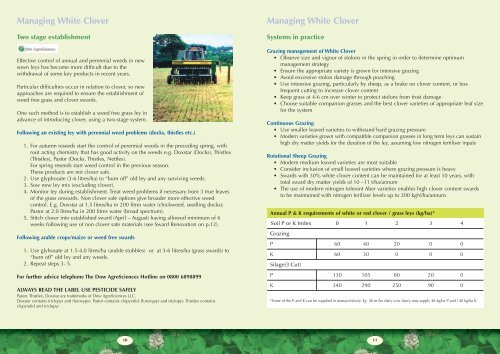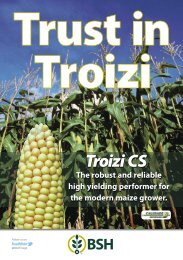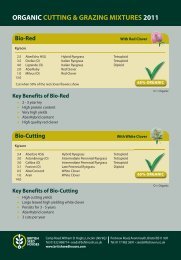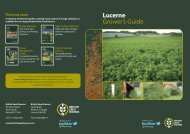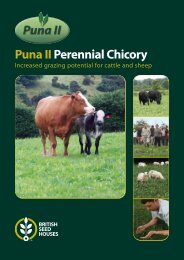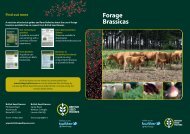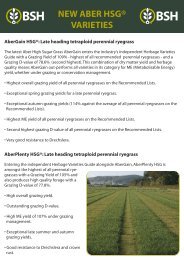You also want an ePaper? Increase the reach of your titles
YUMPU automatically turns print PDFs into web optimized ePapers that Google loves.
Managing <strong>White</strong> <strong>Clover</strong><br />
Two stage establishment<br />
Effective control of annual and perennial weeds in new<br />
sown leys has become more difficult due to the<br />
withdrawal of some key products in recent years.<br />
Particular difficulties occur in relation to clover, so new<br />
approaches are required to ensure the establishment of<br />
weed free grass and clover swards.<br />
One such method is to establish a weed free grass ley in<br />
advance of introducing clover, using a two-stage system.<br />
Following an existing ley with perennial weed problems (docks, thistles etc.)<br />
1. For autumn reseeds start the control of perennial weeds in the preceding spring, with<br />
root acting chemistry that has good activity on the weeds e.g. Doxstar (Docks), Thistlex<br />
(Thistles), Pastor (Docks, Thistles, Nettles).<br />
For spring reseeds start weed control in the previous season.<br />
These products are not clover safe.<br />
2. Use glyphosate (3-6 litres/ha) to “burn off” old ley and any surviving weeds.<br />
3. Sow new ley mix (excluding clover).<br />
4. Monitor ley during establishment. Treat weed problems if necessary from 3 true leaves<br />
of the grass onwards. Non clover safe options give broader more effective weed<br />
control. E.g. Doxstar at 1.5 litres/ha in 200 litres water (chickweed, seedling docks);<br />
Pastor at 2.0 litres/ha in 200 litres water (broad spectrum).<br />
5. Stitch clover into established sward (April – August) having allowed minimum of 6<br />
weeks following use of non clover safe materials (see Sward Renovation on p.12).<br />
Following arable crops/maize or weed free swards<br />
1. Use glyhosate at 1.5-4.0 litres/ha (arable stubbles) or at 3-6 litres/ha (grass swards) to<br />
“burn off” old ley and any weeds.<br />
2. Repeat steps 3- 5.<br />
For further advice telephone The Dow AgroSciences Hotline on 0800 6898899<br />
ALWAYS READ THE LABEL USE PESTICIDE SAFELY<br />
Pastor, Thistlex, Doxstar are trademarks of Dow AgroSciences LLC.<br />
Doxstar contains triclopyr and fluroxypyr. Pastor contains clopyralid, fluroxypyr and triclopyr. Thistlex contains<br />
clopyralid and triclopyr<br />
Managing <strong>White</strong> <strong>Clover</strong><br />
Systems in practice<br />
Grazing management of <strong>White</strong> <strong>Clover</strong><br />
• Observe size and vigour of stolons in the spring in order to determine optimum<br />
management strategy<br />
• Ensure the appropriate variety is grown for intensive grazing<br />
• Avoid excessive stolon damage through poaching<br />
• Use intensive grazing, particularly by sheep, as a brake on clover content, or less<br />
frequent cutting to increase clover content<br />
• Keep grass at 4-6 cm over winter to protect stolons from frost damage<br />
• Choose suitable companion grasses and the best clover varieties of appropriate leaf size<br />
for the system<br />
Continuous Grazing<br />
• Use smaller leaved varieties to withstand hard grazing pressure<br />
• Modern varieties grown with compatible companion grasses in long term leys can sustain<br />
high dry matter yields for the duration of the ley, assuming low nitrogen fertiliser inputs<br />
Rotational Sheep Grazing<br />
• Modern medium leaved varieties are most suitable<br />
• Consider inclusion of small leaved varieties where grazing pressure is heavy<br />
• Swards with 30% white clover content can be maintained for at least 10 years, with<br />
total sward dry matter yields of 10 –11 t/ha/annum<br />
• The use of modern nitrogen tolerant <strong>Aber</strong> varieties enables high clover content swards<br />
to be maintained with nitrogen ferilizer levels up to 200 kgN/ha/annum.<br />
Annual P & K requirements of white or red clover / grass leys (kg/ha)*<br />
Soil P or K Index 0 1 2 3 4<br />
Grazing<br />
P 60 40 20 0 0<br />
K 60 30 0 0 0<br />
Silage(3 Cut)<br />
P 130 105 80 20 0<br />
K 340 290 250 90 0<br />
*Some of the P and K can be supplied in manures/slurry. Eg 40 m 3 /ha dairy cow slurry may supply 48 kg/ha P and 140 kg/ha K.<br />
10<br />
11


